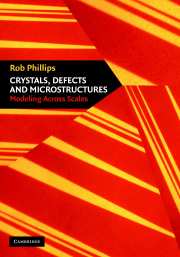Book contents
- Frontmatter
- Contents
- Preface
- Acknowledgements
- Notes on Units, Scales and Conventions
- Part One Thinking About the Material World
- Part two Energetics of Crystalline Solids
- Part three Geometric Structures in Solids: Defects and Microstructures
- 7 Point Defects in Solids
- 8 Line Defects in Solids
- 9 Wall Defects in Solids
- 10 Microstructure and its Evolution
- Part four Facing the Multiscale Challenge of Real Material Behavior
- References
- Index
8 - Line Defects in Solids
Published online by Cambridge University Press: 29 October 2009
- Frontmatter
- Contents
- Preface
- Acknowledgements
- Notes on Units, Scales and Conventions
- Part One Thinking About the Material World
- Part two Energetics of Crystalline Solids
- Part three Geometric Structures in Solids: Defects and Microstructures
- 7 Point Defects in Solids
- 8 Line Defects in Solids
- 9 Wall Defects in Solids
- 10 Microstructure and its Evolution
- Part four Facing the Multiscale Challenge of Real Material Behavior
- References
- Index
Summary
Permanent Deformation of Materials
Steel conjures up images of an absolute rigidity. Yet, as a visit to the most ordinary of steel mills quickly demonstrates, at high enough temperatures a steel bar can be elongated by many orders of magnitude with respect to its initial length. Indeed, it is staggering to stand near a rolling mill, one's face aglow, as a giant block of steel is flattened and stretched into sheet or wire. Similarly, the tungsten filaments which illuminate our homes have had a history rich in permanent deformation with the length of a given bar undergoing extension by factors of as much as 500 000. The physical mechanisms that make such counterintuitive processes possible pose a puzzle that leads us to the consideration of one of the dominant lattice defects, the dislocation.
Dislocations occupy centerstage in discussions of the permanent deformation of crystalline solids largely because of their role as the primary agents of plastic change. The attempt to model such plasticity can be based upon an entire spectrum of strategies. At the smallest scales, appeal can be made to the atomic structure of dislocation cores which can suggest features such as the fact that in certain materials the flow stress increases with increasing temperature. At the other extreme, continuum models of single crystal plasticity are purely phenomenological and make no reference to dislocations except to the extent that they motivate the choice of slip systems that are taken into account.
The task of this chapter is to introduce the key concepts (both continuum and discrete) used in thinking about dislocations with the aim of explaining a range of observations concerning plastic deformation in crystalline solids.
Information
- Type
- Chapter
- Information
- Crystals, Defects and MicrostructuresModeling Across Scales, pp. 362 - 440Publisher: Cambridge University PressPrint publication year: 2001
